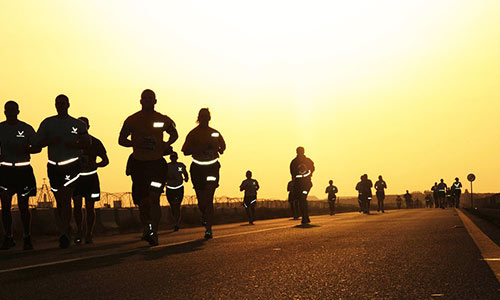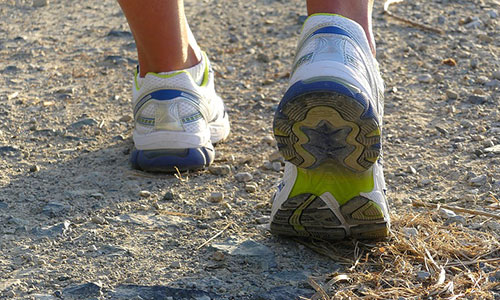Here’s The Difference Between Trail-Running Shoes and Road-Running Shoes
Author

A keen runner, skier and nuts about cycling. Karl lives in Cumbria, where he loves encouraging his two children to follow in his outdoor lifestyle. Whilst out and about keeping active, Karl keeps a diary and shares it with Outdoor Look.
No matter you’re a hiker, runner, or an athlete, there’s this one thing that can create a big difference in a great experience or a useless one – shoes. With a gamut of brands, types, features, and styles of shoes on the market, you might start scratching your head. And with all these confusions, there comes the trail-running shoes and road-running shoes.

Just see and wear both kinds and you’ll feel the difference. Things don’t end here, you need to learn the difference between them if you don’t want to experience a lousy experience while running or walking.
Trail-Running Shoes v/s Road-Running Shoes
Outsole of the Shoes
The bottom of the shoes known as the outsoles are the part that provides maximum grip on the surface while walking or running. Starting with the first and most clear difference, the pattern and size of the outsoles are designed according to the different terrains people will be using to move on. Rubber outsoles are considered one of the best kinds because for their flexibility and lightweight that is easy to adapt to the surface and provides an excellent grip. The material is much softer as compared to other soles, therefore, considering trail-running shoes for walking on the road where your foot might hit on a hard roadway is not a good option.
Coming to the road-running shoes, they come with more leveled and less-knobby outsoles that allow the wearer to run on the cemented roads with stability and consistency. So, the shoes with rubber outsole are much better for the paved floors.
Uppers of the Shoes
Polyester, nylon, and nylon mesh are the common type of materials used in the uppers of the shoe. They are not only designed for a better look but are responsible for the protection of your feet.
While running you’re likely to hit the rocks, sticks, and roots, and this is why the upper of the trail shoes are rugged and often reinforced with synthetic edges, like around the heels, sides, and toes. In fact, there are some models that come equipped with waterproof linings to absorb the moisture. Even though they can be easily worn during wet climate conditions, there comes a limitation. Once the moisture gets in, they become a little tough and slow to drain out as compared to the non-waterproof shoes.
Talking about the road-running shoes, they are designed to walk on the paved or smooth surfaces, which means chances are low that your feet will hit any hard objects. Due to the reason, the uppers of such shoes don’t require much reinforcement and generally have mesh uppers to make them breathable and lightweight.
Midsoles of the Shoes
Midsoles of the shoes are for proper cushioning that helps in preventing any kind of pain and improving body mechanics. It even helps in making the activities comfortable and safer.
Trail-running shoes are equipped with comparatively stiffer midsoles to provide your feet with proper support while walking on the rough tracks and bumpy surfaces. In fact, there are some models that use rock plates between the outsoles and midsoles to protect your feet from any hard-hitting objects. Other deciding factors of a quality pair of shoes are the height of the midsoles, the right amount of cushion, drop, and the type of terrain you want to walk on.
Coming to the road-running shoes, they don’t need the same type of toughness in the midsoles, but the prime purpose of proper cushioning stays the same. Medical posts and torsion bars are common types of things added in the road-running shoes. They are present on the shoe’s sides to keep the extreme inward and outward motion in control.
So, now when you know the differences between the trail-running shoes and road-running shoes, the process of selecting the best and quality pair won’t seem daunting.
Author

A keen runner, skier and nuts about cycling. Karl lives in Cumbria, where he loves encouraging his two children to follow in his outdoor lifestyle. Whilst out and about keeping active, Karl keeps a diary and shares it with Outdoor Look.
Categories
- Sport (28)
- Product Reviews (3)
- Team Outdoor Look (7)
- Mike Wild (2)
- Mike Payton (2)
- Suse Hammond-Pears (3)
- Snowboarding (12)
- Latest Offers (105)
- Shop Talk (1)
- Competitions (7)
- Walking (413)
- Lifestyle Fashion (8)
- Travel (86)
- Kit Guides (176)
- Workwear Clothing (6)
- Safety Workwear (4)
- Health/Fitness (289)
- Skiing (91)
- Great Outdoors (1316)
- Cycling (92)
- January 2025
- December 2024
- November 2024
- October 2024
- September 2024
- August 2024
- July 2024
- June 2024
- May 2024
- April 2024
- March 2024
- February 2024
- January 2024
- December 2023
- November 2023
- October 2023
- September 2023
- August 2023
- July 2023
- June 2023
- May 2023
- April 2023
- March 2023
- February 2023
- January 2023
- December 2022
- November 2022
- October 2022
- September 2022
- August 2022
- July 2022
- June 2022
- May 2022
- April 2022
- March 2022
- February 2022
- January 2022
- December 2021
- November 2021
- October 2021
- September 2021
- August 2021
- July 2021
- June 2021
- May 2021
- April 2021
- March 2021
- February 2021
- January 2021
- December 2020
- November 2020
- October 2020
- September 2020
- August 2020
- July 2020
- June 2020
- May 2020
- April 2020
- March 2020
- February 2020
- January 2020
- December 2019
- November 2019
- October 2019
- September 2019
- August 2019
- July 2019
- June 2019
- May 2019
- April 2019
- March 2019
- February 2019
- January 2019
- December 2018
- November 2018
- October 2018
- September 2018
- August 2018
- July 2018
- June 2018
- May 2018
- April 2018
- March 2018
- February 2018
- January 2018
- December 2017
- November 2017
- October 2017
- September 2017
- August 2017
- July 2017
- June 2017
- May 2017
- April 2017
- March 2017
- February 2017
- January 2017
- December 2016
- November 2016
- October 2016
- September 2016
- August 2016
- July 2016
- June 2016
- May 2016
- April 2016
- March 2016
- February 2016
- January 2016
- December 2015
- November 2015
- October 2015
- September 2015
- August 2015
- July 2015
- June 2015
- May 2015
- April 2015
- March 2015
- February 2015
- January 2015
- December 2014
- November 2014
- October 2014
- September 2014
- August 2014
- July 2014
- June 2014
- May 2014
- April 2014
- March 2014
- February 2014
- January 2014
- December 2013
- November 2013
- October 2013
- September 2013
- August 2013
- July 2013
- June 2013
- May 2013
- April 2013
- March 2013
- February 2013
- January 2013
- December 2012
- November 2012
- October 2012
- September 2012
- August 2012
- July 2012
- June 2012
- May 2012
- April 2012
- March 2012
- February 2012
- January 2012
- December 2011
- November 2011
- October 2011
- September 2011
- August 2011
- May 2010
- April 2010
- March 2010
- February 2010
- January 2010
- November 2009
- October 2009
- September 2009
Submit a Comment